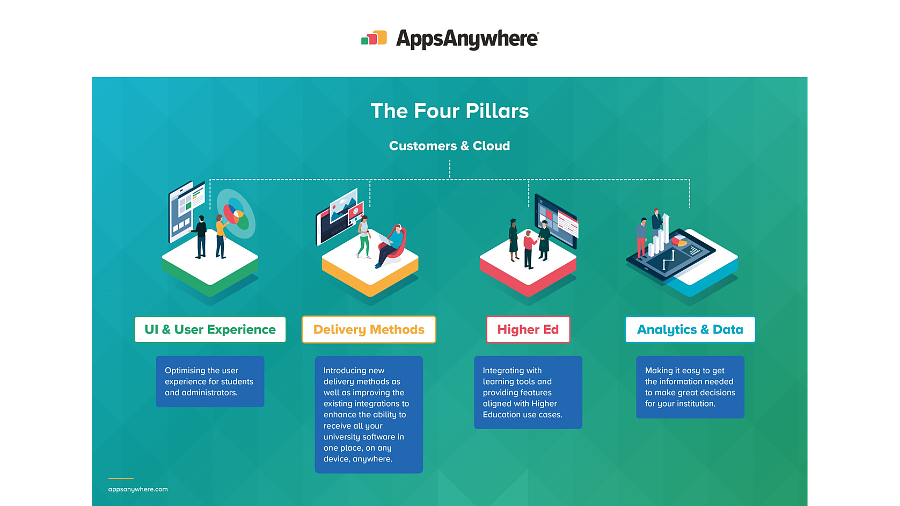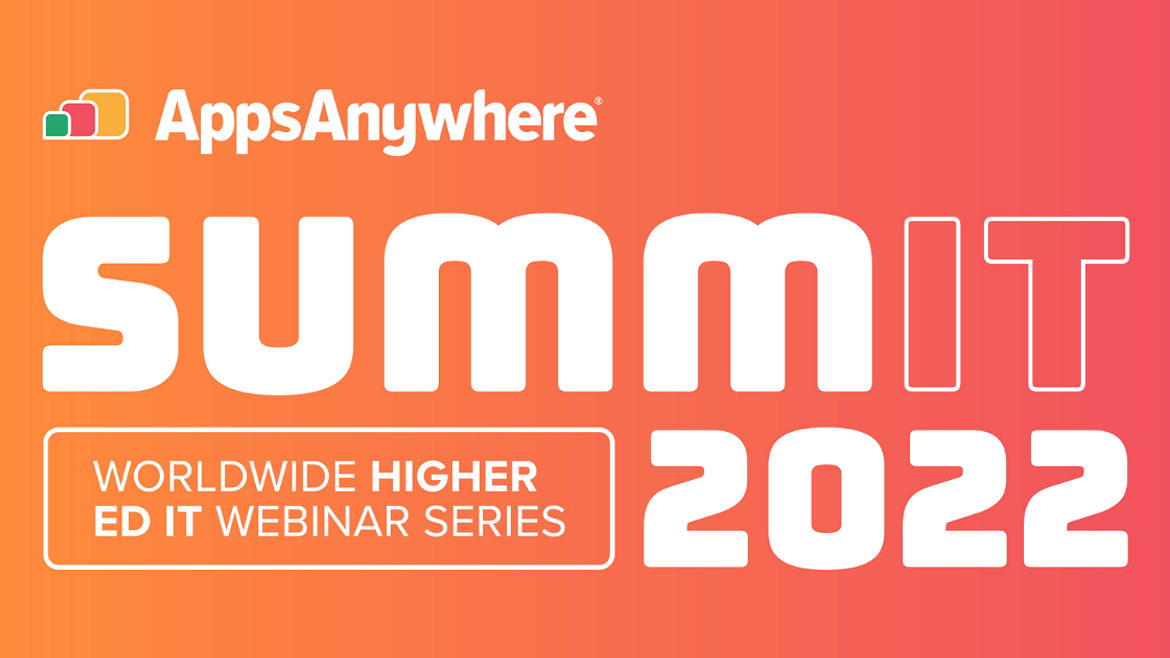The Roadmap: Looking Towards 3.0
AppsAnywhere Product Manager, Spencer Vale lifts the curtain on the highly anticipated version 3 of AppsAnywhere. Following on from the newly-introduced...

At AppsAnywhere, we’re committed to helping and supporting the higher ed industry through innovation and improving the student experience.
Listening to feedback and conducting research, our development team are always looking at how we can work with higher ed institutions to; improve student outcomes, make life easier for IT teams, and save institutions money that can be repurposed to enhance their student experience.
Earlier this year we launched AppsAnywhere 2.12, and with many students kickstarting their studies, we’re starting to see the benefits of the new features that we’ve introduced. Looking back is only one aspect though. We’re thrilled to look ahead to one of our most exciting releases, AppsAnywhere 3.0.
As we approach the release of AppsAnywhere 3.0, Product Manager, Spencer Vale, focuses on some of the great features from our previous release, the exciting new features that higher ed institutions will be able to get their hands on, as well as diving into the AppsAnywhere roadmap and what the future holds for our ongoing journey.
“When it comes to development at AppsAnywhere, we’re always working towards four core pillars. Higher Education, User Experience, Delivery Methods & Analytics.

“Higher Education is the foundation layer that we need to make sure we’re always thinking about - staying true to our customers and making sure it’s at the forefront of our minds.
“Then, User Experience is the sandwich layer because whether you’re a student and we’re trying to achieve great outcomes, or whether you’re an administrator and we’re trying to deliver a great service to students, we’re always thinking about improving the two user experiences together.
“Then we have two value streams. We have integrations, tools, and technologies to ensure we are offering as many Delivery Methods as we can, and using our Analytics features to help institutions make great decisions with data that is at their fingertips.
“We’re always asking ourselves: What’s the best student outcome that we can create with AppsAnywhere? All our answers are interlinked with our four core pillars. All four are essential to our development and so with every version release, these are what guide our path.
Earlier this year, we launched AppsAnywhere 2.12 and we’ve already seen a lot of customers using the new features. It really is the stepping stone towards 3.0 as the release features pave the way, such as our new user interface and hardware detection capabilities starting the foundations for our next release to build upon.
“Students nowadays are used to searching – that’s the main way they find what they need – instead of by navigating a menu. We saw this from our research and took that understanding to make a search function front and center. That was a real nod towards how and why we’re creating AppsAnywhere 3.0. We’re offering an alternative experience that focuses on the easiest way to access applications and software. Currently, with AppsAnywhere, users have the opportunity to favorite applications and create App-Lists. One of the things that we’re really excited to introduce in AppsAnywhere 3.0 is our Recent and New collections; Recent meaning ones that the student has recently launched, and New meaning ones recently added to the system by the administrator.
“It’s all about options and making sure students have many ways in which to access their software as quickly and as easily as possible. Higher ed institutions may have over 100 different applications for many different courses, so by improving our user interface in this way, we’re helping to streamline it from not only the students’ perspective but also an admin’s.
“I’d really like to also mention our accessibility efforts. We want AppsAnywhere to be inclusive and accessible for all. So, the whole UI can be navigated by keyboard or voice software if needed, and the whole display is within contrast guidelines too.
“We launched our Hardware Profiles feature in AppsAnywhere 2.12. We heard a lot of feedback from our existing and prospective customers about large applications that require a lot of processing power or specific device requirements to get a satisfactory experience. Since we enable students to access software anywhere, anytime, on any device, and they might not always be using the best device for that software all the time, this was definitely something we could help with.
“Digital equity is important to us and making sure that students can all access software, regardless of their device capabilities is something we wanted to ensure. Hardware detection does just this by understanding the capability of a student’s device and profiling it against the administrator’s delivery methods.
“An administrator can create a profile, for instance, profile A needs 32GB of RAM and a dedicated graphics card. Then, they apply that profile to delivery methods for certain applications that require a lot of local processing power. So, what happens is when a student runs AppsAnywhere, the client knows their device capability, if their device doesn't meet that requirement it won’t launch by that delivery method and will launch by the next best delivery method giving the best experience possible.
“What we're doing is improving the user experience but also helping institutions keep costs down by students not launching software via VDI when they don't need to. But when they really do need to, that's the path it will take. So again, we're keeping higher education in mind, we're keeping the user experience in mind and we're giving more tools to the institution to make the right choices about their technology.
“AppsAnywhere 3.0 really represents a step change in our journey where we’re rearchitecting the product. We’re developing an API structure underneath the hood that enables us to roll out feature releases more frequently, and this is, in a way, a step beyond 3.0 and towards the launch of our AppsAnywhere SaaS version in the future where people can subscribe online, be hosted online, and manage the software all in one place.
“In the meantime, though, we’re always thinking about our four core pillars, we’re really proud to say that in AppsAnywhere 3.0 we will be delivering new features aligned in each one.
“We've seen the new user interface from AppsAnywhere 2.12 improving the user experience by making it easier for students and admins alike. We’re adding an extra UI element in AppsAnywhere 3.0 in the form of Dark Mode. I cast my mind back to the AppsAnywhere Toronto User Day and this was something everyone was talking about. The beauty of AppsAnywhere is that students can use it anytime and so offering alternative displays is something we know a lot of our users will be pleased to have.
“We're adding more delivery methods, such as our ongoing efforts with Amazon to integrate with Amazon AppStream technology which we know our customers are really excited for. It’s also not just new delivery methods either, we’re enhancing existing integrations such as Azure Virtual Desktop too. We’re keen to keep turning the dial on all the tools we offer as well as putting more in the toolbox.
“We've been adding more into the LMS integration space too. Currently, we integrate with Canvas. AppsAnywhere 3.0 will see us integrating with Blackboard and gathering feedback and research around BrightSpace and Moodle.
“Lastly, analytics-wise, we want to keep providing meaningful data to help institutions make great decisions. At the moment, we provide our Dashboards feature with analytics capability to help institutions make the right choices around their licensing. Helping to answer questions such as: Do I still need to support this application? Can we reduce the number of licenses we have? How many students are launching each application?
“In AppsAnywhere 3.0, we want to provide as much of that data as we can in the place where they can action changes based on it. For example, when reviewing how many launches an application has had. In the list of applications on the admin side, we want to show the number of users to help streamline the task. This is just one example of our analytics path as the possibilities are endless on this front.
“So, as I say, we’re constantly looking to deliver across all four product pillars. We're listening to feedback, looking at our research and saying, “Ok, this is our foundation. This is our direction and looking at how the next step in the journey can help to improve student outcomes better than the last.”
“AppsAnywhere 3.0 does have a lot of new breakthrough features and it’s a new milestone. We're embracing the jump and excited to embark the next part of our roadmap.”
“The intention after the launch of AppsAnywhere 3.0 is to keep adding value against each of our product pillars. We’re always looking for feedback from AppsAnywhere users which is truly what drives our development.
We’re proudly focused on the higher ed industry and finding ways to help support and move the industry forward is what we’re ultimately trying to achieve.
Product Update led by our Product Manager, Spencer Vale, and accompanied by UI Lead, Lewis Howles and Development Manager, James McNab. This session looked into our recent release 2.12 as well as the upcoming 3.0!

To get the latest version if you are currently using AppsAnywhere, schedule a call with your specialist implementations team and we can help you to start benefiting from AppsAnywhere 2.12 now.
We’re excited to be releasing AppsAnywhere 3.0 in December 2022, in time for January enrolment. Your dedicated Customer Success team will be in touch when it’s available to ensure your institution gets the most out of AppsAnywhere.

Sign up to our newsletter.
AppsAnywhere is a global education technology solution provider that challenges the notion that application access, delivery, and management must be complex and costly. AppsAnywhere is the only platform to reduce the technical barriers associated with hybrid teaching and learning, BYOD, and complex software applications, and deliver a seamless digital end-user experience for students and staff. Used by over 3 million students across 300+ institutions in 22 countries, AppsAnywhere is uniquely designed for education and continues to innovate in partnership with the education community and the evolving needs and expectations of students and faculty.


Register your interest for a demo and see how AppsAnywhere can help your institution. Receive a free consultation of your existing education software strategy and technologies, an overview of AppsAnywhere's main features and how they benefit students, faculty and IT, and get insight into the AppsAnywhere journey and post launch partnership support.

Register your interest for a demo and see how AppsAnywhere can help your institution. Receive a free consultation of your existing education software strategy and technologies, an overview of AppsAnywhere's main features and how they benefit students, faculty and IT, and get insight into the AppsAnywhere journey and post launch partnership support.